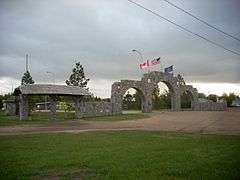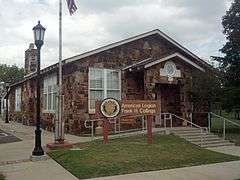WPA Rustic
WPA Rustic architecture is an architectural style from the era of the U.S. New Deal Works Project Administration. The WPA provided funding for architects to create a variety of buildings, including amphitheaters and lodges.[1] WPA architecture is akin to National Park Service rustic architecture.
WPA Rustic, as opposed to National Park Service Rustic as utilized in most national parks, involves more demarcation between the building and the landscape.[2]
The term has been used by the National Park Service's National Register of Historic Places program to describe many buildings and structures, including American Legion meeting halls and other buildings built by the WPA in the 1930s.
Examples
Examples include the following:[3]
Arkansas
North Dakota
- Grand Forks County Fairgrounds WPA Structures, Grand Forks, North Dakota
Oklahoma
See also
References
- ↑ Linda Flint McClelland (1998), Building the national parks: historic landscape design and construction, JHU Press, p. 420, ISBN 978-0-8018-5583-2
- ↑ http://www.historycolorado.org/oahp/wpa-rustic
- ↑ National Park Service (2009-03-13). "National Register Information System". National Register of Historic Places. National Park Service.
External links
![]() Media related to Buildings by the Works Progress Administration at Wikimedia Commons
Media related to Buildings by the Works Progress Administration at Wikimedia Commons

